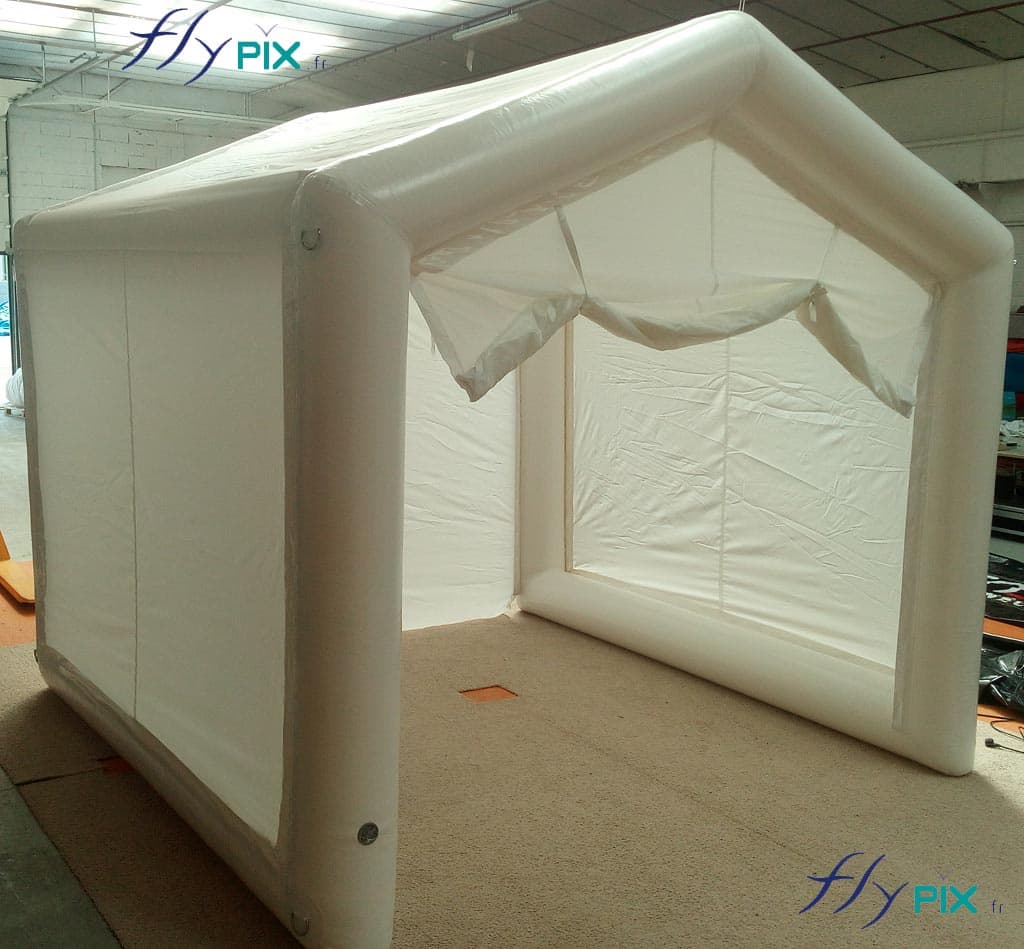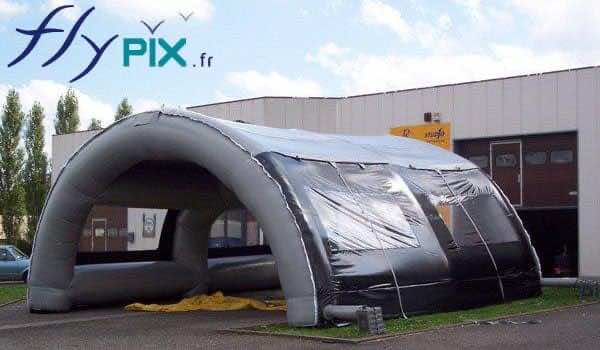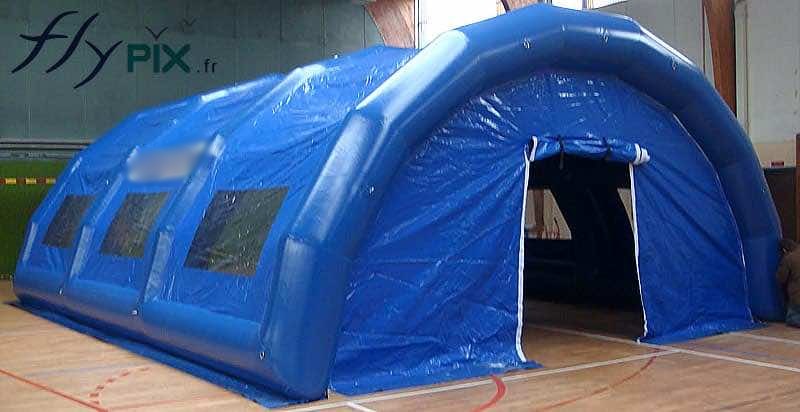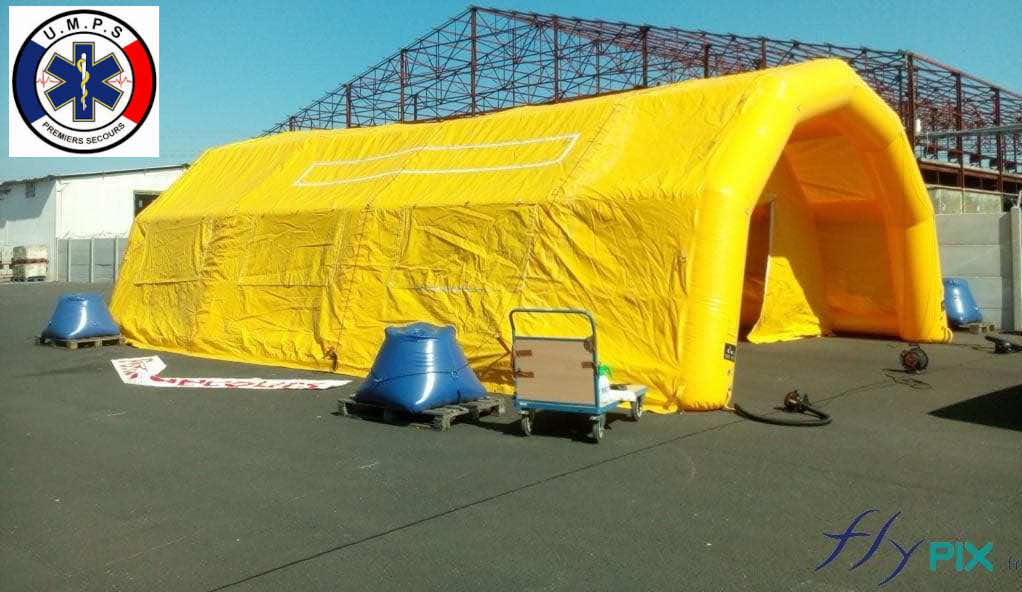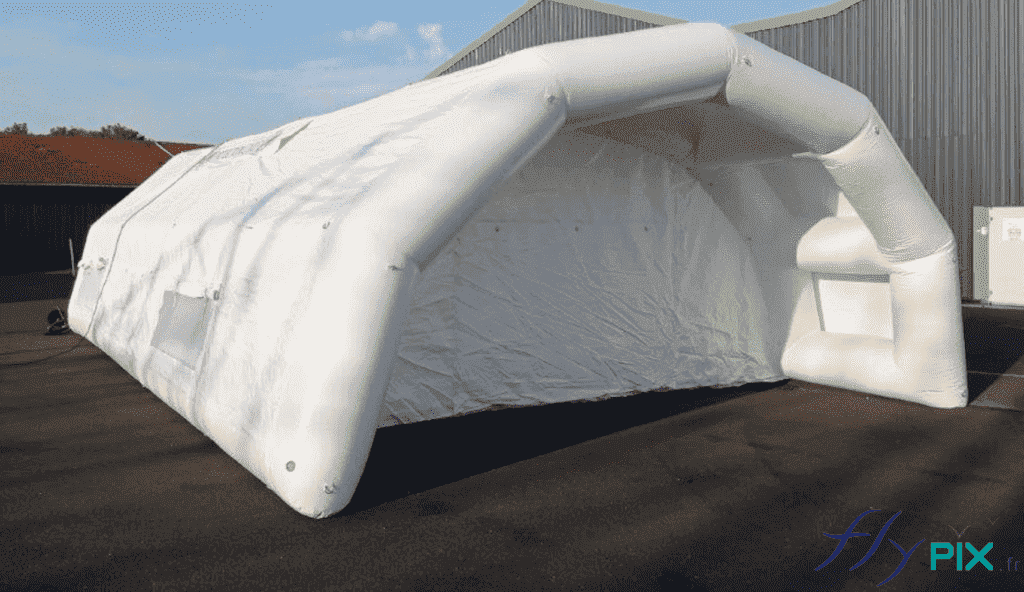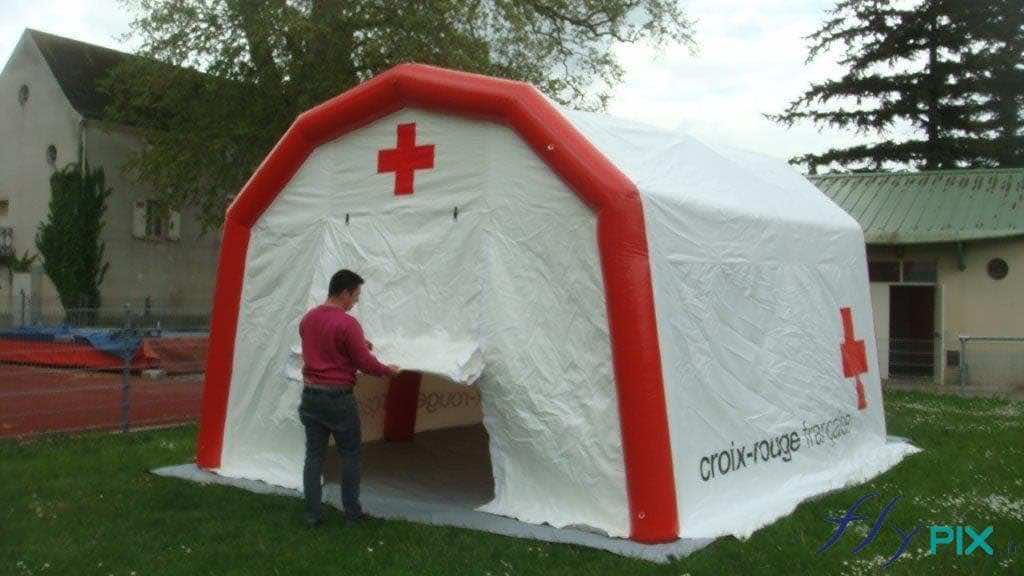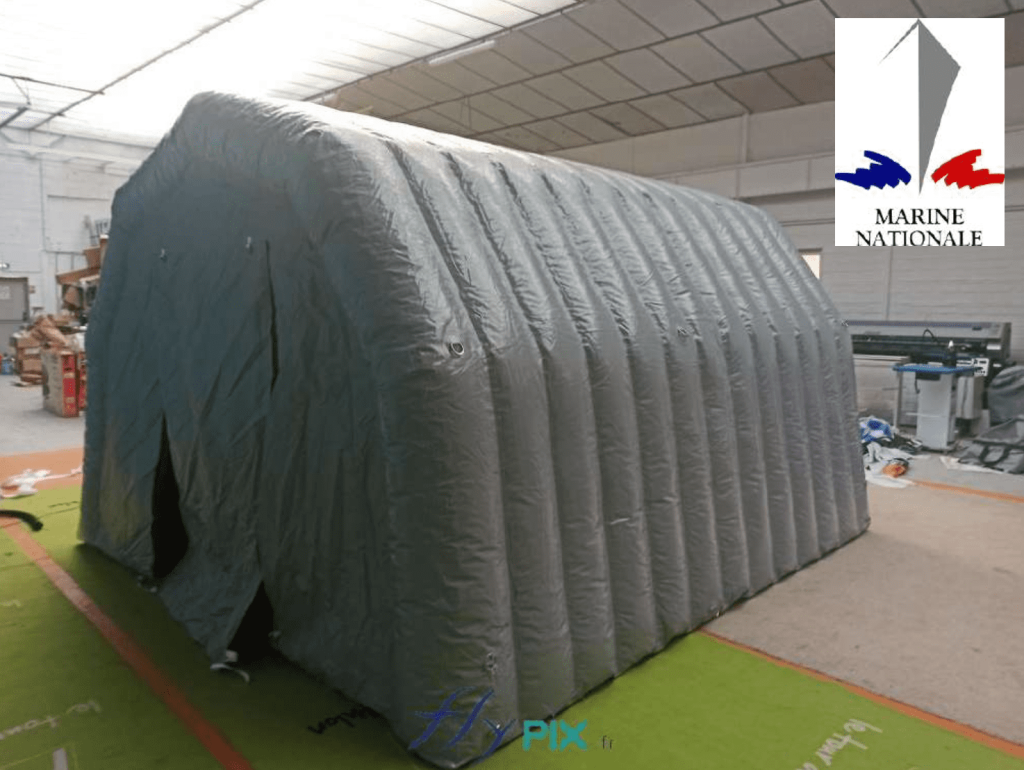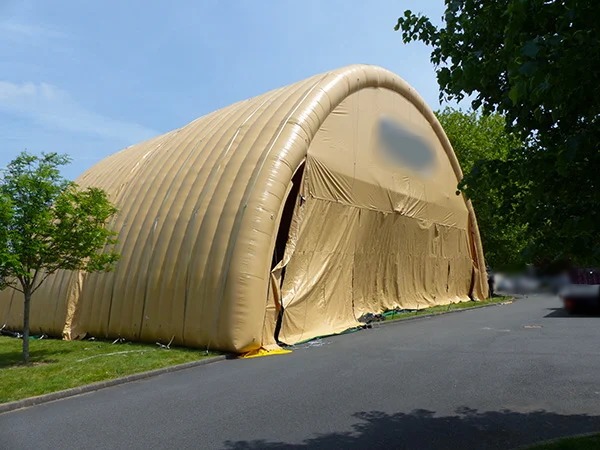Inflatable military protections (tents, shelders, sheds, hangars)
In the crucible of modern warfare, where speed, adaptability, and resilience dictate victory, mobile inflatable shelters, tents, and hangars emerge as unsung titans.
These air-supported bastions—swift to rise, versatile in function, and tough as the theaters they inhabit—redefine military operations.
From forward operating bases to field hospitals, they empower commanders to project power, sustain troops, and outmaneuver adversaries amidst the chaos of conflict.
We explore unveils their myriad advantages, weaving a narrative of tactical ingenuity and operational supremacy that anchors the fight in any battlespace.

Why use inflatable shelters during military operations or in conflict zones, during war contexts?
- Rapid Deployment: Establishing Dominance in Minutes
- Mobility and Logistics: Agile Force Projection
- Command and Control: Orchestrating Operations from the Field
- Medical Support: Sustaining the Fighting Force
- Weapon and Ammunition Storage: Securing Lethal Assets
- Vehicle and Equipment Maintenance: Keeping the Arsenal Operational
- Stealth and Camouflage: Evading Enemy Detection
- Resilience in Combat Zones: Enduring the Fog of War
Deployment and Mobility
- Rapid Setup: Erected in minutes for instant operational readiness.
- Portability: Lightweight, collapsible for airlift or ground haul.
- Tactical Agility: Relocates swiftly to exploit battlefield shifts.
- Scalability: Links units for small ops or theater-wide bases.
- Logistical Ease: Minimizes manpower and transport demands.
Operational Support
- C2 Capability: Houses secure, mobile command posts.
- Weapons Security: Fortifies arms and ammo against theft or attack.
- Maintenance Hubs: Sustains vehicles and gear in combat zones.
- Medical Lifeline: Provides trauma care and casualty staging.
- Flexibility: Adapts to diverse mission profiles (e.g., raids, sieges).
Combat Resilience
- Durability: Withstands weather, shrapnel, and wear.
- Stealth: Camouflaged to evade ISR and targeting.
- Repairability: Quick fixes maintain uptime under fire.
- Environmental Shielding: Protects assets from dust, rain, and heat.
- Endurance: Supports prolonged ops without degradation.
Strategic Value
- Force Multiplier: Amplifies combat effectiveness and reach.
- Cost-Effectiveness: Affordable vs. permanent infrastructure.
- Future-Proofing: Integrates emerging tech for next-gen warfare.
- Global Deployability: Suits any conflict, from jungles to deserts.
- OPSEC Enhancement: Bolsters security and mission secrecy.
This article dissects the transformative role of mobile inflatable shelters, tents, and hangars in military operations and warfare.
It examines their contributions to rapid deployment, logistical agility, command and control (C2), medical support, weapons storage, equipment maintenance, stealth, and combat resilience.
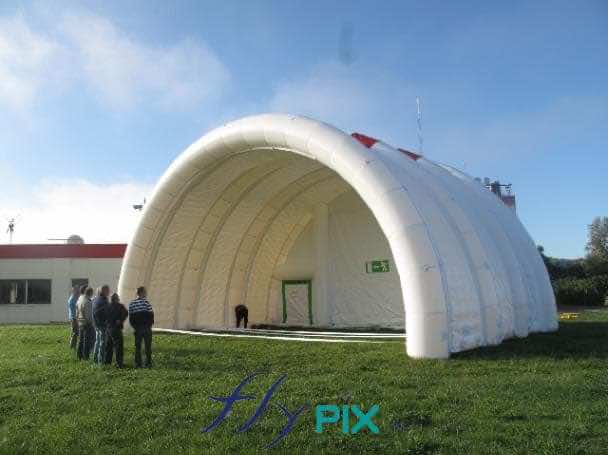
The battlespace of the 21st century is a relentless proving ground, where agility often trumps armor and adaptability outstrips firepower.
Into this fray step mobile inflatable shelters, tents, and hangars—portable redoubts that fuse engineering brilliance with martial necessity.
These air-inflated strongholds—erected in the shadow of artillery barrages or the stillness of covert ops—offer militaries a decisive edge, supporting everything from high-stakes command posts to life-saving field hospitals.
Their rise heralds a new era of warfare, one where the ability to deploy, sustain, and strike hinges on infrastructure as dynamic as the forces it serves.

Gone are the days when military encampments meant cumbersome canvas tents or static bases vulnerable to enemy targeting.
Inflatable shelters, forged from high-tensile fabrics like PVC and TPU, and bolstered by airbeam technology, stand ready to transform barren terrain into operational hubs within hours.
Their lineage traces from humanitarian relief to the frontlines of Operation Enduring Freedom, where they’ve sheltered special forces, housed artillery shells, and mended the wounded under fire.
This introductory salvo charts their ascent, framing them as linchpins in the “kill chain”—from planning to execution—and the “combat lifesaver” continuum—from injury to recovery.
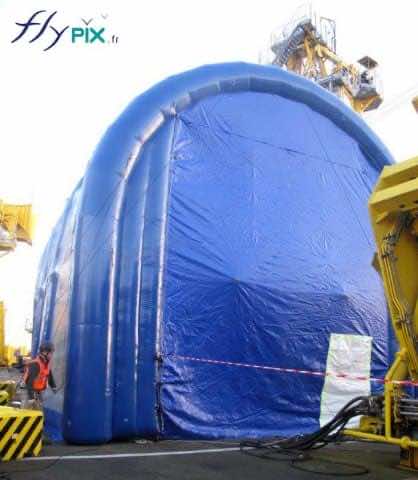
In the high-stakes arena of warfare, where the first mover often claims the upper hand, rapid deployment is the heartbeat of victory.
Mobile inflatable shelters, tents, and hangars embody this principle, rising from compact kits to fully operational outposts in mere minutes—a feat that redefines the tempo of military operations.
These air-supported enclaves—erected with the urgency of a firefight and the precision of a drill—enable forces to seize the initiative, establish a foothold, and project power before the enemy can react.
Their speed is not just an asset; it’s a weapon, honed to perfection in the crucible of conflict.
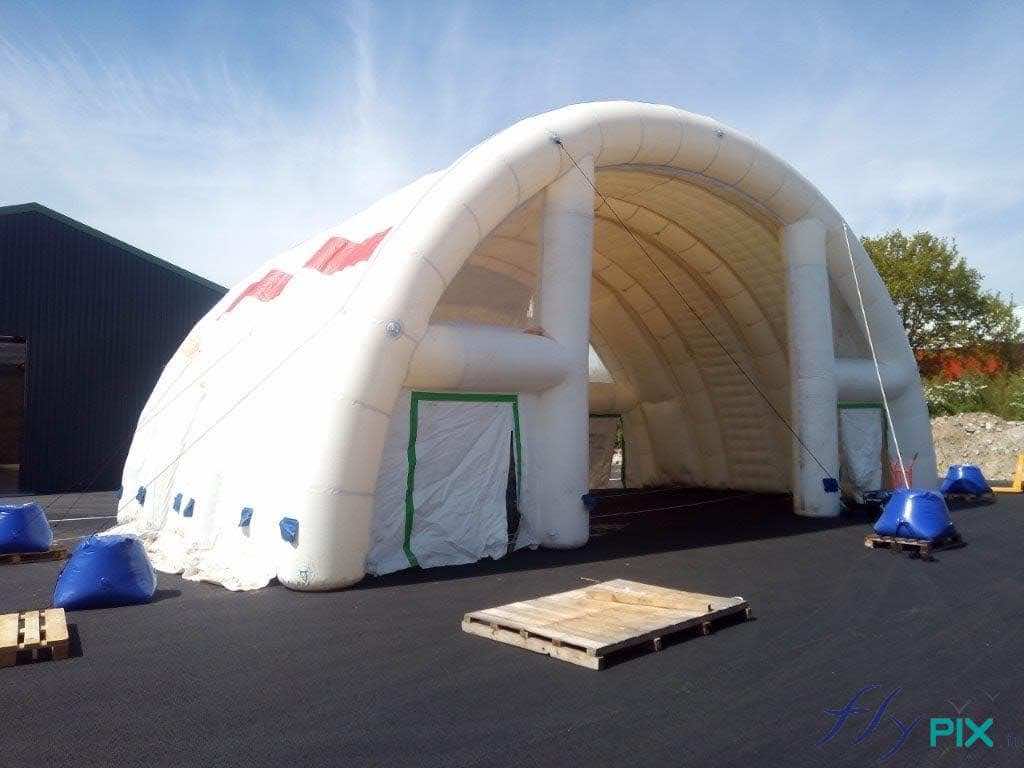
The mechanics of this swift emplacement are a marvel of modern engineering. A standard inflatable tent—say, a 20-square-meter command post—can be unpacked and inflated in under 15 minutes using portable blowers or pre-charged gas cylinders.
Contrast this with the hours or days required to assemble a traditional encampment with metal poles or prefab modules, and the tactical dividend is stark.
In a scenario like a rapid insertion behind enemy lines, a special operations group (SOG) can drop with an inflatable shelter, set up a “hide site” for recon, and begin HUMINT (human intelligence) collection before hostile forces regroup.
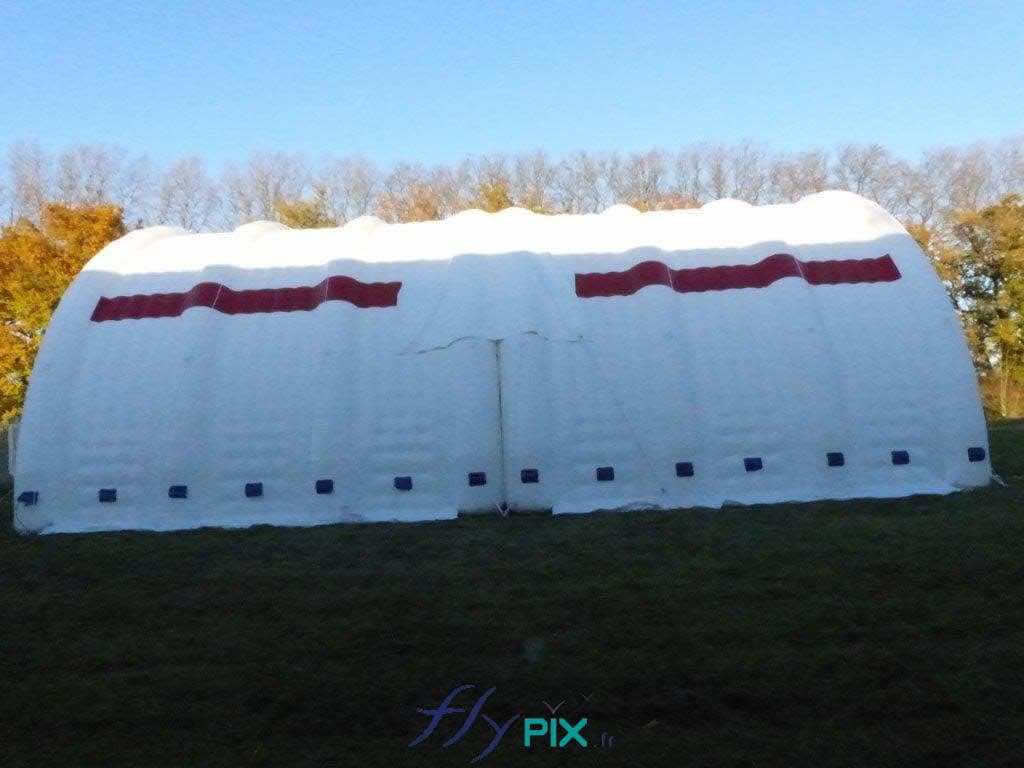
This celerity extends to larger constructs. An inflatable hangar—capable of housing a platoon’s worth of gear or a fleet of drones—can be operational in under an hour, complete with lighting, ventilation, and modular partitions.
During Operation Desert Storm analogs, such speed allowed coalition forces to establish forward operating bases (FOBs) in record time, staging air assets and resupply points deep in contested zones.
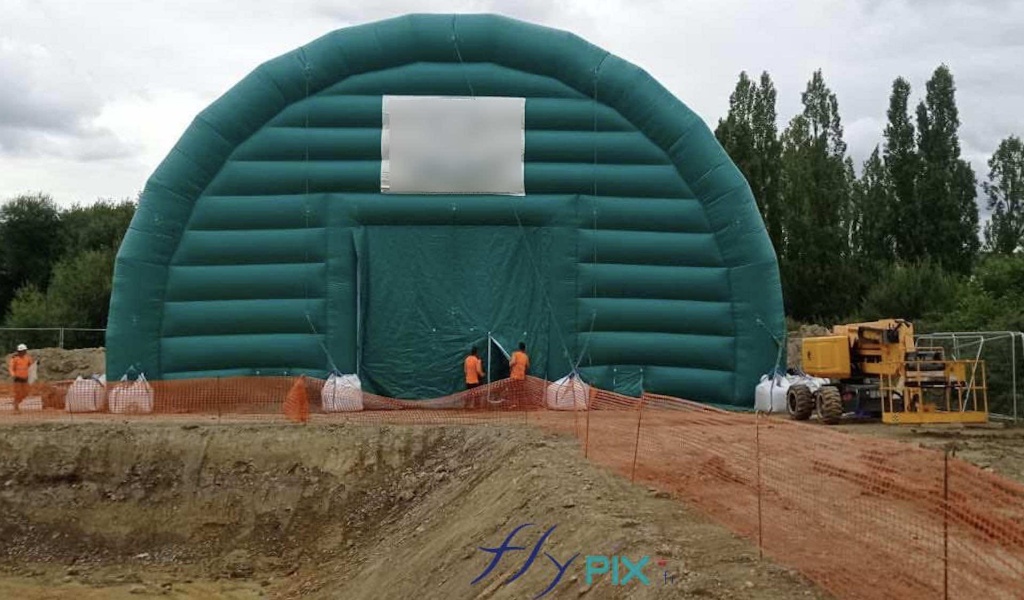
Tactical flexibility amplifies their rapid-deployment prowess. Unlike fixed installations, these shelters adapt to the mission’s cadence—erected for a fleeting raid, then collapsed and relocated as the battlespace shifts.
A brigade combat team (BCT) might deploy an inflatable C2 (command and control) node to coordinate a flanking maneuver, only to dismantle it overnight and reposition to exploit a breach.
This “shoot-and-scoot” philosophy—borrowed from artillery doctrine—ensures that forces remain elusive, dodging enemy ISR (intelligence, surveillance, reconnaissance) and counterstrikes.
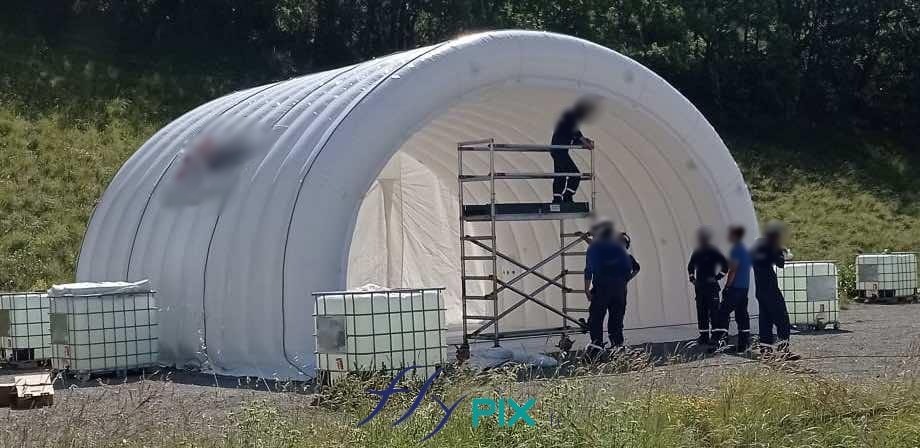
In medical contexts, speed saves lives. An inflatable field hospital—equipped with trauma bays, surgical suites, and triage stations—can rise amidst the chaos of a mass casualty incident (MCI), stabilizing the wounded within the “golden hour.”
Picture a battalion taking heavy fire: medics inflate a shelter under mortar rounds, establishing a casualty collection point (CCP) to staunch hemorrhages, administer IV fluids, and prep for MEDEVAC.

Scalability enhances this advantage.
A single tent might shelter a squad’s gear, while a linked network of hangars—spanning acres—can support a division-level offensive, housing command staff, munitions, and repair crews.
This modularity ensures that speed doesn’t compromise capacity, a synergy that rigid structures struggle to match.
Case studies abound: in NATO exercises, inflatable shelters stood up FOBs in under two hours, enabling simulated airstrikes, while in Afghanistan, they supported quick-reaction forces (QRFs) with pop-up ammo dumps and comms hubs.

In essence, rapid deployment isn’t just a logistical triumph—it’s a doctrinal revolution.
Inflatable shelters hand militaries the keys to the battlespace, allowing them to dictate terms, outpace foes, and sustain the fight.
They are the vanguard of a new warfare paradigm, where the swift and adaptable reign supreme.
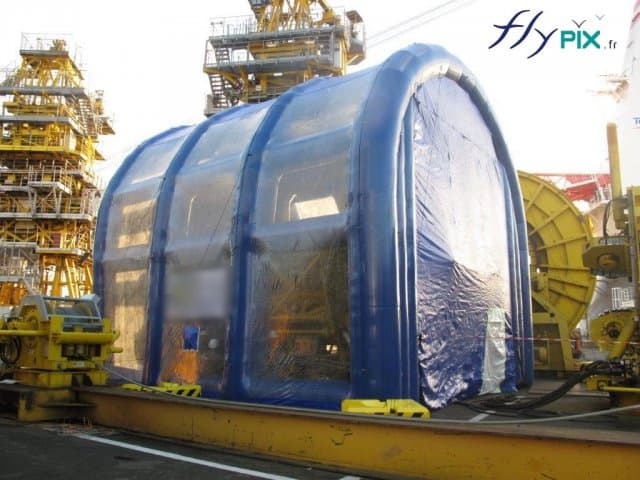
In warfare, mobility is the lifeblood of success, and inflatable shelters, tents, and hangars deliver unparalleled logistical agility.
These lightweight sanctuaries—collapsible into compact, transportable packages—enable militaries to project force across vast, hostile theaters with minimal burden.
Weighing a fraction of rigid structures, they’re airlifted by C-130s, slung beneath CH-47 Chinooks, or hauled on flatbeds, ready to spring into action wherever the fight demands.
This “expeditionary footprint” shrinks the logistical tail, freeing troops from the shackles of ponderous supply chains.
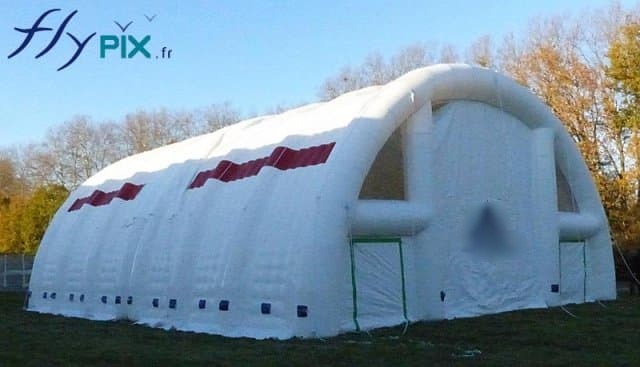
Picture a rapid-response scenario: a mechanized brigade must pivot from a desert stronghold to a mountain pass ambush.
Traditional bases would lag, but inflatable shelters collapse in under an hour, stowed in rucksacks or cargo holds, then redeployed at the new site.
This “jump capability”—a nod to airborne doctrine—keeps pace with the fluid battlespace, whether it’s a jungle insurgency or an arctic standoff.

Their compact storage is a game-changer. A hangar that spans 500 square meters deflates into a crate the size of a Humvee’s bed, slashing transport costs and space.
In Operation Iraqi Freedom, such shelters supported quick-reaction forces (QRFs), moving ammo dumps and repair bays overnight to counter IED threats.
This portability dovetails with austere environment adaptability—erected on sand, snow, or rubble, they need no flat foundations, only a compressor and a squad.
Medics, too, benefit: a trauma tent air-dropped to a remote firebase becomes a lifeline, stocked with IVs and defibrillators, no runway required.
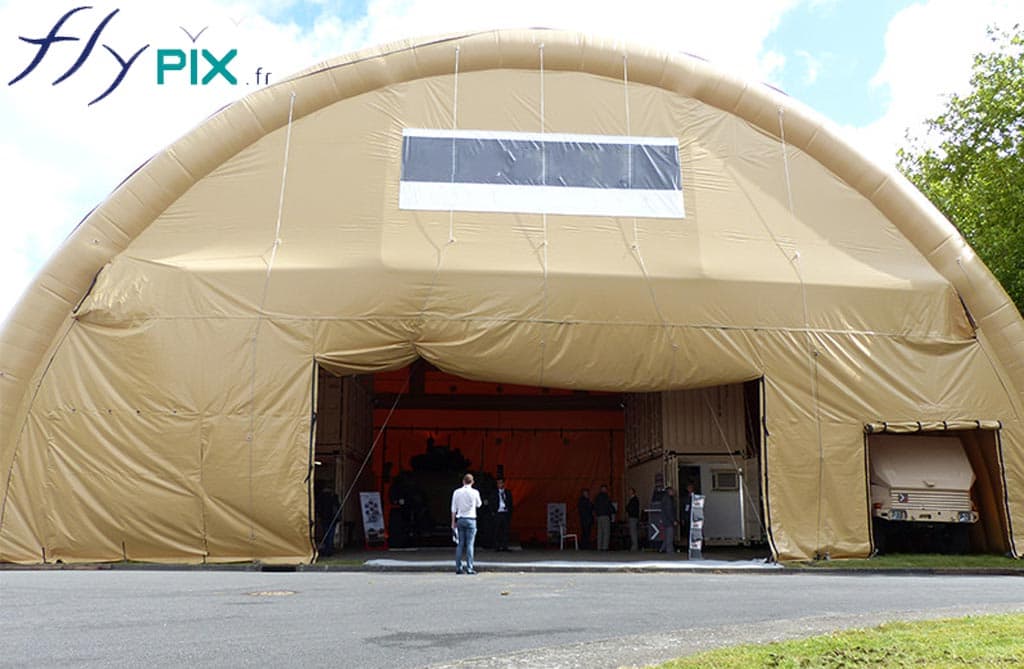
The nerve center of any military operation is its command and control (C2), and inflatable shelters provide a mobile, secure hub to orchestrate the chaos of war.
These inflatable citadels—equipped with comms suites, satellite uplinks, and map tables—rise swiftly, giving commanders a perch to direct troops, drones, and airstrikes from the heart of the fray.
Their rapid setup—a 30-minute inflation—turns a barren ridge into a tactical HQ, outpacing the lumbering pace of prefab trailers.
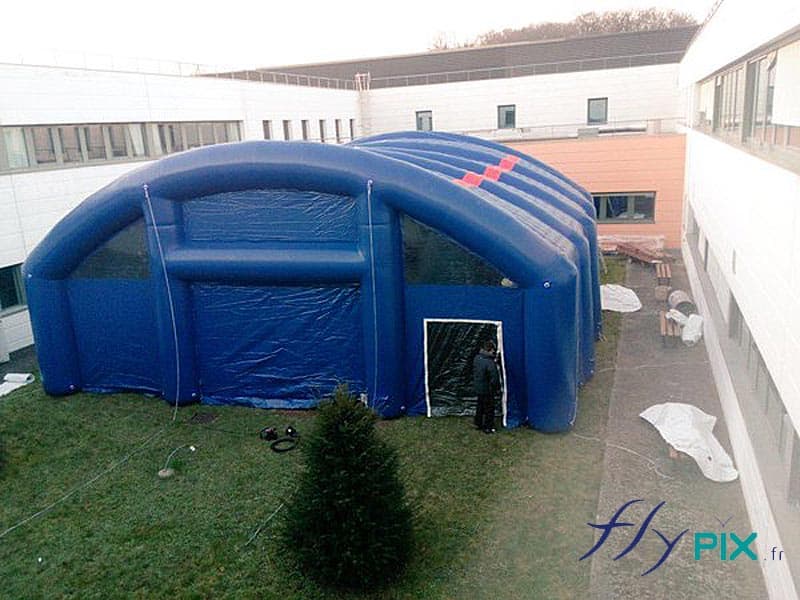
Security is paramount. Reinforced with ballistic linings and EMP-hardened fabrics, these shelters shield sensitive gear—radios, laptops, GPS—from enemy sabotage or electronic warfare (EW).
In Syria, inflatable C2 nodes coordinated coalition strikes, their low profile dodging Russian SIGINT (signals intelligence). The jargon—“battlespace awareness,” “OPSEC,” “C4ISR” (command, control, communications, computers, intelligence, surveillance, reconnaissance)—captures their role as the brain behind the brawn.
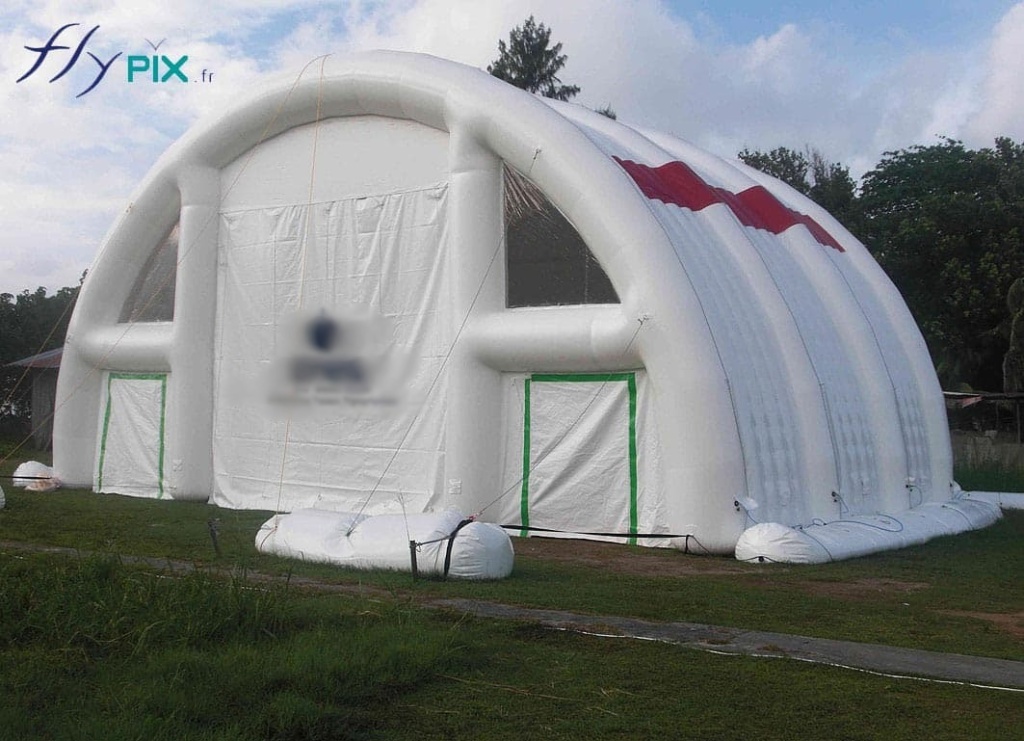
Integration with tech elevates their utility. UAV control stations fit snugly inside, relaying real-time feeds from Reapers overhead, while modular walls create briefing rooms or crypto vaults.
Medics tie in too—a C2 tent might double as a MEDEVAC coord point, syncing choppers with casualty collection points (CCPs). Their mobility ensures they keep pace with the front, relocating as lines shift, a “rolling HQ” that static bunkers can’t match.
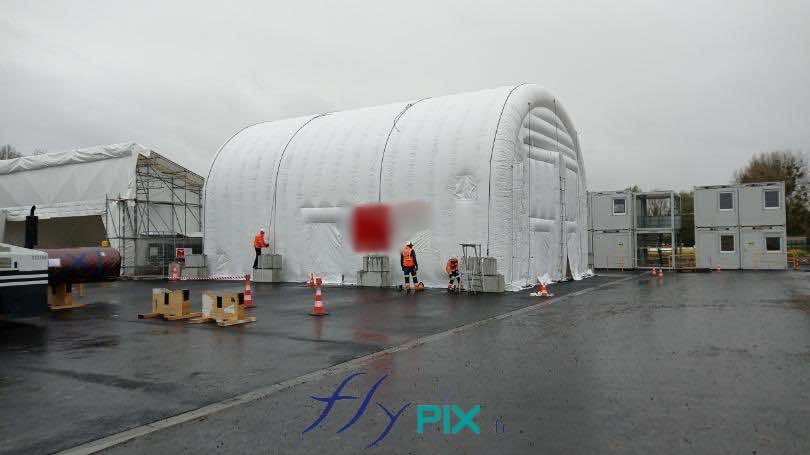
War chews through flesh, and inflatable shelters are the medics’ bulwark to mend it. These mobile havens—housing trauma bays, surgical suites, and triage zones—sustain the fighting force, turning battlefields into lifelines.
Their rapid deployment stands out: a field hospital inflates in under an hour, ready with ventilators, sutures, and blood bags to snatch troops from death’s jaws within the “golden hour.”
In Helmand Province, such shelters saved countless limbs under Taliban fire.

Protection is key. Sealed against dust, rain, and shrapnel, they maintain sterile fields for emergency thoracotomies or burn care, while HEPA filters block biohazards—a must in CBRN-tinged wars.
The jargon—“point-of-injury care,” “combat lifesaver (CLS),” “patient throughput”—defines their mission, as medics stabilize GSWs (gunshot wounds) for MEDEVAC.
Scalability shines too: a tent for a platoon’s cuts grows into a hangar for a battalion’s mass casualties, linking wards with airlocks.
Mobility keeps them close to the fight—air-dropped to a firebase or trucked to a frontline CCP, they’re where the bleeding happens.

In war, firepower is king, and inflatable shelters guard its crown jewels—weapons and ammo.
These fortified vaults—swift to erect, tough to breach—secure rifles, RPGs, mortars, and HE (high explosive) rounds, ensuring troops stay armed and lethal.
Their rapid access design—lockable flaps and modular racks—lets a squad rearm in minutes, critical during a firefight’s ebb and flow.
Security is ironclad. Ballistic-grade linings thwart small arms, while camouflage netting hides them from enemy drones or HUMINT. In
Ukraine’s Donbas, inflatable ammo dumps evaded Russian artillery spotters, preserving the fight.
The jargon—“ordnance integrity,” “force lethality,” “ammo forward”—nails their role.
Environmental resilience protects too—waterproof seals and climate control keep rust off M4s and dampness from C4, even in monsoons or deserts.
Scalability fits any arsenal: a tent for a platoon’s sidearms or a hangar for a company’s ATGM (anti-tank guided missile) stash.
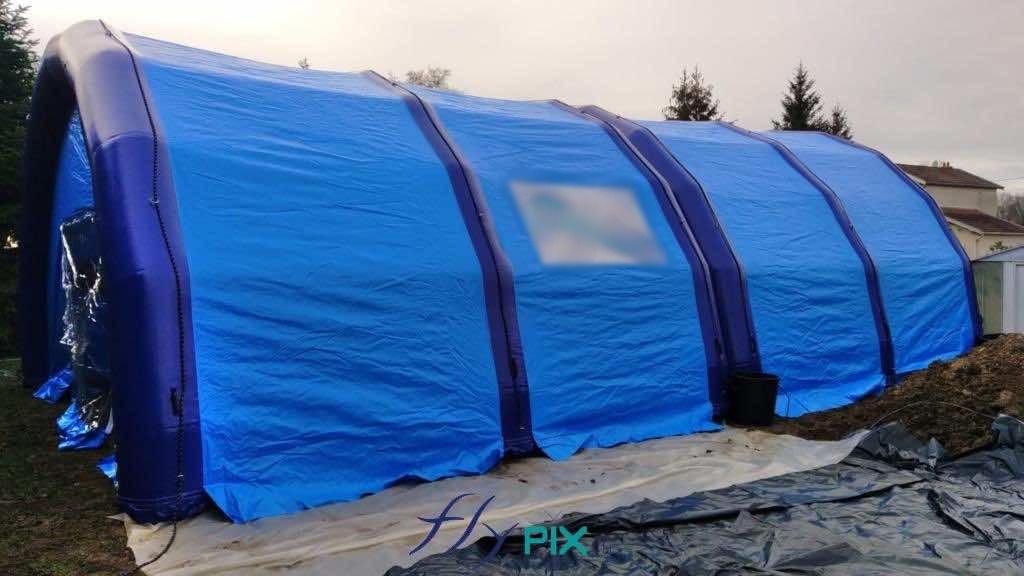
War machines—tanks, Humvees, drones—grind down without care, and inflatable shelters keep them humming.
These repair bays—spacious, resilient, mobile—house tools, cranes, and spare parts, turning dirt patches into garages under fire.
Their rapid setup—a hangar up in 90 minutes—means a busted Bradley gets tracks swapped before the enemy counterattacks.
Durability stands firm: windproof fabrics and shrapnel-resistant linings shield mechanics from storms or stray rounds, while dust filters save engines from grit.
In Iraq, inflatable bays nursed MRAPs back to life amidst sandstorms.
The jargon—“operational readiness,” “mean time to repair (MTTR),” “fleet uptime”—defines their worth.
Mobility keeps them near the fight—airlifted to a ridge or towed to a firebase, they follow the armor.
Scalability fits all: a tent for drone tweaks or a hangar for Abrams overhauls.
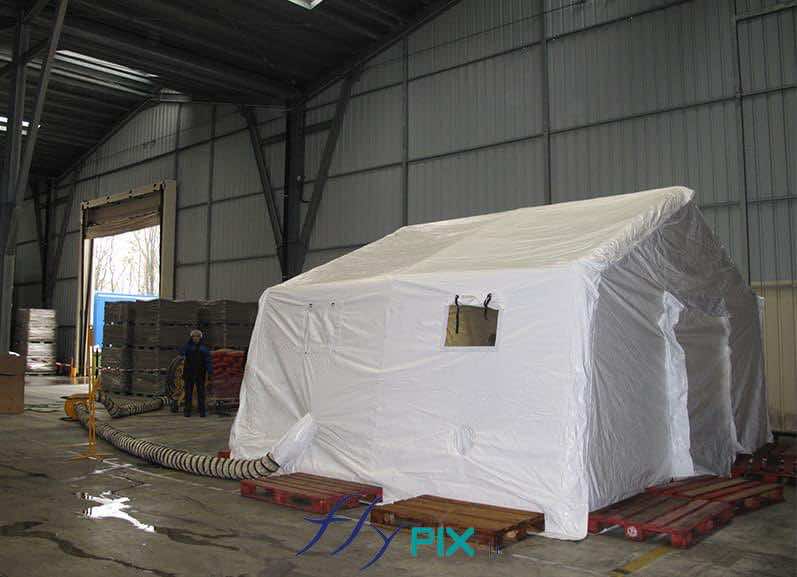
In war’s deadly chess, invisibility is power, and inflatable shelters master stealth.
Their low-profile design—no towering silhouettes—blends into hills or dunes, while camouflage netting or IR-suppressing fabrics dodge enemy ISR—drones, satellites, thermal scopes.
In Yemen, Houthi scouts missed inflatable FOBs, preserving coalition ops.
The jargon—“OPSEC,” “signature management,” “deception ops”—nails their craft.
Rapid relocation enhances this: deflate, move, reinflate elsewhere, foiling targeting locks.
Their lightweight build aids concealment—less dust kicked up than prefab rigs. Medics benefit too—hidden trauma tents evade sniper fire.

War is relentless, and inflatable shelters endure its wrath.
Built from TPU and Kevlar blends, they shrug off wind, rain, and shrapnel, standing firm where canvas rips.
In Syria, they weathered barrel bombs, keeping C2 alive. Quick repairs—patch kits fix tears mid-battle—ensure uptime, a nod to “combat resilience.”
Environmental toughness shines: UV coatings defy sun, antifungal layers beat mold, and anchors grip mud or sand. Medics rely on this—a trauma bay holds steady in monsoons.
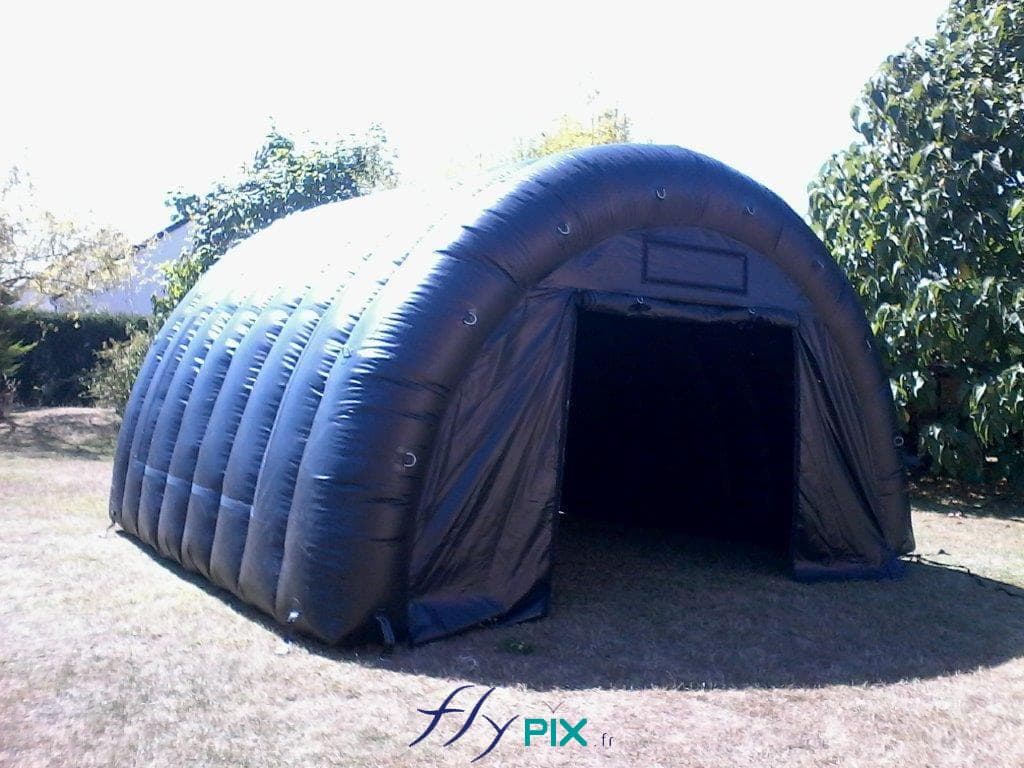
Inflatable shelters aren’t static—they’re evolving. Smart tech—sensors for threats, solar panels for power—ushers them into hybrid warfare.
In exercises, AI-linked tents tracked enemy movements, feeding C2 in real time. Cost-effectiveness—cheaper than bunkers—drives adoption, from NATO to Africa’s militias.
Future roles expand: drone hubs, cyberwar nodes, even space ops bases. Medics see upgrades—tents with telemedicine suites.
The jargon—“next-gen warfighting,” “tech integration,” “global reach”—hints at their horizon.
The full section would explore prototypes, Pentagon budgets, and visions of inflatable forts on Mars, all rooted in today’s battles.
